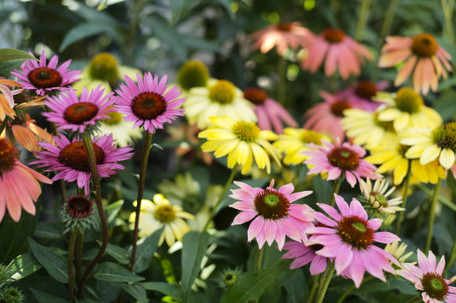Echinacea
Posted by Jessie Jacobson on Aug 4th 2024
Echinacea (Coneflower)
There’s nothing quite like the commanding presence of summer perennial blooms, especially the familiar rainbow of blooms of the numerous cultivars of purple coneflower, Echinacea purpurea (ek-i-NAY-sha pur-PUR-ee-uh), an important North American native perennial.
Part of the Aster family, Asteraceae, coneflowers are incredibly easy and carefree plants for adding bright color to the garden, requiring little additional care once established. No matter the color you have in mind, there’s likely a coneflower out there for you.
Echinacea prefer to be planted in well-draining, dry to moderately moist soil in areas of full sun, requiring little water once established in the garden. Coneflower range in size from roughly 18-36" tall and 12-24" wide, depending on the variety, and will bloom from early summer through fall. Spent blooms may be deadheaded to encourage reblooming, however many modern varieties will continue to bloom without any additional care.
Though the purple coneflower is beloved, and for good reason, there is only one coneflower truly native to Minnesota, the narrow-leaved coneflower, Echinacea angustifolia (ek-i-NAY-sha an-gus-tee-FOH-lee-uh). A smaller species, narrow-leaved coneflower matures to 18-24" tall and wide with coarse, narrow leaves and soft pink-purple blooms, blooming abundantly from eary summer through mid-summer, with great drought tolerance once established. Narrow-leaved coneflower is a fantastic native for low sunny borders, water-wise designs, and also boulevard plantings thanks to their compact stature.
As their name implies, coneflowers will bloom from the outside inward, transforming the flower into a cone-like shape as the flower blooms concentrically. Coneflower blooms shine when massed in sunny borders, pollinator gardens, and foundation plantings. Their flowers are also a wonderful treat for pollinators like bees and butterflies, and if left to self-seed, not only can provide great winter interest, but are also a great food source for songbirds throughout the cold winter months.
Happy Planting!

